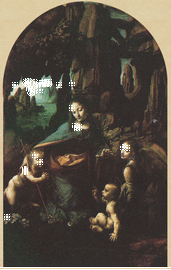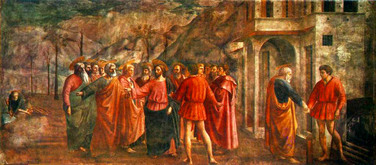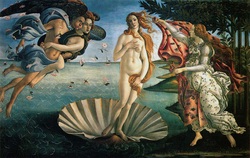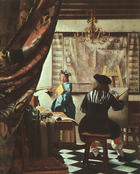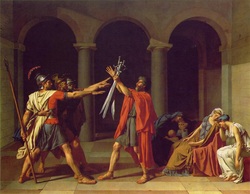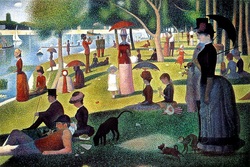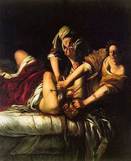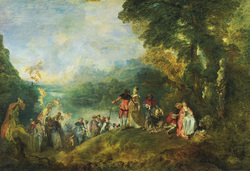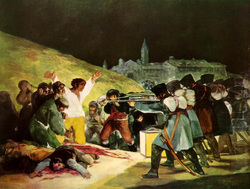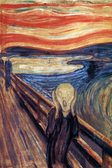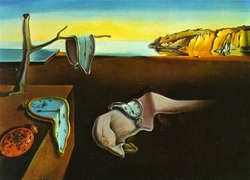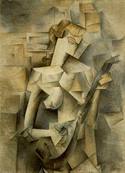Perspective was first introduced in art during the Renaissance. There are multiple ways of using perspective to create a 3D effect. Here are a few ways we've learned about.
One point perspective- In one point perspective the flat side of the object you draw is facing you. You establish the flat side of the object first, then converge all of the receding lines to one vanishing point which is directly across from your station point. When an artist uses one point perspective correctly his painting should create an illusion of being a window through which the immobile eye of the observer looks at an outside 3-dimensional world. This use of perspective is clearly seen in the painting Rafael's School of Athens and Albrecht Durer's 1525 engraving.
Atmospheric Perspective- Leonardo Da Vinci used a new method of incorporating perspective in a painting. This method was called atmospheric perspective. Atmospheric perspective is when you take into account the distance between the objects or landscapes that you are painting and use colors that correspond accurately to the object at the given distance. A perfect example of atmospheric perspective is the painting Virgin of the Rocks by Leonardo Da Vinci. He uses atmospheric perspective to portray a totally new sense of realism. Da Vinci illustrates atmospheric perspective throughout his entire painting, but it’s most clearly seen by examining the mountains in the painting. The ones that are closer and upfront give off a brown color because your able to see the true color of a mountain from a short distance. The farther mountains are painted blue and hazy because mountains from a farther distance they do not show their true color due to the clouds and atmosphere masking it.
Narrative Perspective- Perspective was also used to provide narrative focus. Realizing the human eye would most likely travel to the vanishing point of the painting artists, of the Renaissance, began to put something important near that point. This use of perspective can clearly be seen in Masaccio's Tribute Money. In this painting, Masasccio puts Jesus's head at the vanishing point wanting viewers to concentrate on it.
Paul Cézanne- Born in January 19, 1839, Cézanne was a post impressionist that formed the bridge between impressionism and cubism. When spectators views Cézanne's works, they viewed various objects with binocular vision. Cézanne was one of the first artists to create pieces of art with depth perception. Cézanne started to create paintings that allowed people to see multiple objects from multiple perspectives. This use of perspective influenced other artists such as Picasso, to start a new movement called perspective. A famous painting that usually comes up when Cézanne's name is mention is Still Life With Fruit. In this painting, spectators are able to see the fruit and bowl from multiple points of view, a technique that was rarely seen in previous art works.
Phases of Art
Renaissance
Birth of Venus -Sandro Botticelli
Northern Realism
The Artist's Studio -Vermeer
Neoclassicism
Oath of Horatti -Jaques-Lois David
Impressionism
La Grande Jatte -Seruat
Baroque
Judith and Holofernes -Gentileschi
Rocco
Pilgrimage to Cythera -Jean-Antionne Watteau
Romanticism
The Third of May -Goya
Expressionism
The Scream -Edvard Munch
Surrealism
Persistence of Memory -Dali
Cubism
Cubism- A form of art that allows viewers to see various objects or people from multiple perspectives. Two pioneers that have become famous through the use of cubism are Pablo Picasso and Georges Braque. Both of these artists created multiple perspectives in their paintings, distorting the props used in their painting and the colors that belong to the prop itself. In Picasso's painting, Woman Playing the Mandolin, viewers are able to see a woman from multiple points of view, painted with various shades of gray.
M.C. Escher- Born in June 17, 1898, Escher grew up to become one of history's greatest artists. Escher created new worlds and images that no one before him had really thought about. In the 1930's, Escher started to use one point perspective. By using it he created two pieces of art called Savona and Still Life and Street. These two painting give off a three dimensional feeling. Your able to see the buildings in both paintings with a three dimensional view while also looking at the objects or people in front of the buildings from an aerial perspective. Immediately most viewers assume that they are viewing into this painting as if they were above the ground. As Escher gets older he starts to progress into much more complex ideals such as multiple perspectives. His use of multiple perspectives is clearly seen in his paintings Up and Down, Relativity, and Convex and Concave. These three paintings allow viewers to enter a world of multiple perspectives. Each perspective has its own point of view on a certain object or view.
Expressionism
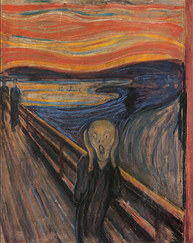
In this painting, there are multiple perspectives to consider. Not only did Munch use linear perspective in this painting, but he incorporated his own. He expresses his own feelings through this painting. By looking at the man in the painting, you are able to see the depression and loneliness building up in this man. Not only should people consider the perspective of the artist, but that of those viewing the painting. Each person ties in his own experiences to analyze the painting. For example, while some see a depressed lonely guy others view a man in awe or shock. It's all about the life experiences that influence one's perspective. I grew up watching "Home Alone" and every time the main character would puts his hands on his cheeks, the same way the man is in the picture, it would be a result of shock.
_____________________________________________________________________________________________________________
Sources:
http://www.jkrweb.com/art/images/guernica.jpg
http://www.thecaveonline.com/APEH/arttitle.html
http://www.artemisia-gentileschi.com/new_images/judith6.jpg
http://cgfa.acropolisinc.com/vermeer/vermeer4.jpg
http://www.oneonta.edu/faculty/farberas/arth/Images/110images/sl18_images/Watteau_cythera.jpg
http://www.artchive.com/artchive/d/david/david_oath.jpg
http://www.jackiewhiting.net/ArtHist/Images/thirdofmay.jpg
http://bob520.files.wordpress.com/2011/04/la-grande-jatte.jpg
http://screammasks.net/wp-content/uploads/2010/07/the-scream-edvard-munch2.jpg
http://www.virtualdali.com/assets/paintings/31PersistenceOfMemory.jpg
http://www.thecaveonline.com/APEH/manpointing.gif
See all sources on our bibliography.
Sources:
http://www.jkrweb.com/art/images/guernica.jpg
http://www.thecaveonline.com/APEH/arttitle.html
http://www.artemisia-gentileschi.com/new_images/judith6.jpg
http://cgfa.acropolisinc.com/vermeer/vermeer4.jpg
http://www.oneonta.edu/faculty/farberas/arth/Images/110images/sl18_images/Watteau_cythera.jpg
http://www.artchive.com/artchive/d/david/david_oath.jpg
http://www.jackiewhiting.net/ArtHist/Images/thirdofmay.jpg
http://bob520.files.wordpress.com/2011/04/la-grande-jatte.jpg
http://screammasks.net/wp-content/uploads/2010/07/the-scream-edvard-munch2.jpg
http://www.virtualdali.com/assets/paintings/31PersistenceOfMemory.jpg
http://www.thecaveonline.com/APEH/manpointing.gif
See all sources on our bibliography.

